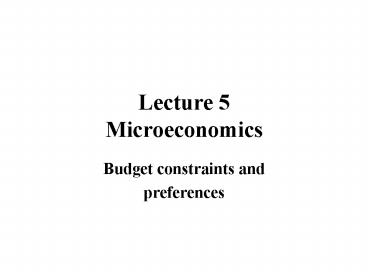Lecture 5 Microeconomics - PowerPoint PPT Presentation
1 / 34
Title:
Lecture 5 Microeconomics
Description:
Indifference. curve. Ranking ... Indifference. curves. cannot cross! Implication of transitivity. Assumption 4 ... Indifference curves are downwards sloping. ... – PowerPoint PPT presentation
Number of Views:161
Avg rating:3.0/5.0
Title: Lecture 5 Microeconomics
1
Lecture 5 Microeconomics
- Budget constraints and
- preferences
2
The Economic Model of Behaviour
- Individuals act.
- Incentives determine behaviour.
- Incentives are produced by preferences and
constraints. - Preferences and constraints are strictly
distinguished. - Individuals pursue their own interests.
3
Outline
- Look behind the demand curve and describe what
consumers are doing. - Constraints the budget set.
- Objectives preferences.
4
Three questions
- How do we describe what the consumer can afford
to consume? - How do we describe what the consumer likes to
consume? - How do we describe what the consumer actually
ends up consuming?
5
A model of consumer choice
Step 1 Preferences (what consumers want to do)
Step 3 Budget Constraint (what consumers can do)
Step 3 The decision (what consumers actually do)
6
Basic assumptions about behaviour
- The consumer selects from the set of affordable
options, the option that maximises his or her
objectives. - The consumer selects the bundle of goods which
gives him or her the most satisfaction subject to
what he or she can afford to buy.
7
The budget constraint
- One (representative) consumer.
- Two types of goods x and y.
- A bundle of goods (x,y).
- The consumer has a given income m.
- The consumer takes the prices, px and py, of the
two goods as being out of their control.
8
The budget line
Expenditure on good x
Expenditure on good y
Assume that the consumer wants to spend all
income.
9
Objective terms of trade
Relative price
Real income
10
y
The budget line
m/py
1
-px/py
The budge set.
x
m/px
11
Comparative statics
- Increase in consumer income, m
- Increase in the price of good x
- Increase in the price of good y
12
An increase in income
y
New budget line (m1)
m1/py
Old budget line (m0)
m0/py
x
m1/px
m0/px
13
An increase in the price of good x
y
New budget line
m/py
Old budget line
x
Q
m/p0x
m/p1x
14
An increase in the price of good y
y
New budget line
m/p0y
Old budget line
m/p1y
Q
x
m/px
15
Question
- Suppose prices of the two goods are 1.
- You can choose between getting
- 10 in addition income
- 10 units of good x for free
- Which option would you choose?
16
y
New budget line (m1)
m1
Old budget line (m0)
10
m0
New budget line (m1)
x
m1
m0
10
10
17
Preference theory
- The objective is to describe the consumers taste
or, as economists say, the consumers preference - and to deduce from that what kind of consumption
choices she would like to make.
18
Preferences Taste
Ranking of alternatives
Utility function
Indifference curve
19
Ranking
- For every (relevant) pair of bundles, the
consumer makes a comparison and conclusions - Strict preference
- X strictly preferred to Y.
- Weak preference
- X weakly preferred to Y.
- Indifference
- X is as good as Y.
Ranking of the alternative bundles of goods
20
Assumption 1 and 2
Completeness.
The consumer can rank (all) bundles of goods
according to his or her preferences.
Reflextivity
A bundle of goods is at least as good as itself.
21
Assumption 3
Transitivity
Y
X
Z
22
Transitivity in words
- If the consumer prefers X to Y and
- she prefers Y to Z, then
- she prefers X to Z.
23
Indifference curves
An indifference curve shows all the consumption
bundles among which the consumer is indifferent.
24
(No Transcript)
25
Implication of transitivity
Indifference curves cannot cross!
y
A
B
C
x
26
Assumption 4
Monotonicity
The consumer prefers more of all goods to less of
all goods.
More is better than less...
27
Admissible indifference curve
y
Preferred region
y0
Dominated region
x
xo
28
Consequences of assumption 4
- Indifference curves are downwards sloping.
- Commodities that the consumer likes (i.e., goods)
versus commodities that she dislikes (i.e.,
bads). - The consumer is never satisfied.
- Satiation point beer!
29
Assumption 5Convexity
The consumer prefers average bundles of goods
to extreme bundles.
Example A bundle with 5 apples and 5 oranges is
preferred to a bundle with 10 apples or 10
oranges only.
30
Admissible indifference curve
y
Average bundles
2
1.5
1
x
2
1
1.5
31
Summary
- Assumptions 1 to 5, i.e.,
- reflectivity
- completeness
- transitivity
- more is better than less (monotonicity)
- average is better than extreme (convexity)
- produce what is called well-behaved preferences.
32
Well-behaved preferences
y
x
33
Summing up
- The budge constraint describes what the consumer
can do. - The consumers preferences describes what the
consumer wants to do.
34
What is next?
- Alternative way of representing the consumers
preferences the utility function. - Optimal consumption choices.































